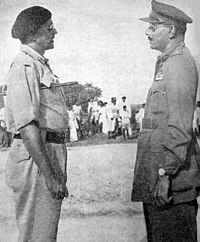Hyderabad State was a state in Independent India, formed after the accession of the princely state of Hyderabad into the Indian Union on 24 November 1949. It existed from 1948 to 1956.
Following the States Reorganisation Act Hyderabad State was merged with Andhra State in 1956 and renamed Andhra Pradesh.
HIstroy
Operation Polo, the code name of the Hyderabad "Police Action" was a military operation in September 1948 in which the Indian Armed Forces invaded the State of Hyderabad and overthrew its Nizam, annexing the state into the Indian Union.
At the time of Partition in 1947, the princely states of India, who in principle had self-government within their own territories, were subject to subsidiary alliances with the British, giving them control of their external relations. In the Indian Independence Act 1947 the British abandoned all such alliances, leaving the states with the option of opting for full independence. However, by 1948 almost all had acceded to either India or Pakistan. One major exception was that of the wealthiest and most powerful principality, Hyderabad, where the Nizam, Osman Ali Khan, Asif Jah VII, a Muslim ruler who presided over a largely Hindu population, chose independence and hoped to maintain this with an irregular army recruited from the Muslim aristocracy, known as the Razakars. The Nizam was also beset by the Telangana uprising, which he was unable to subjugate.
The Indian government, anxious to avoid what it termed a Balkanization of what had been the Indian Empire, was determined to effect the integration of Hyderabad into the new Indian Union. Amidst atrocities by the Razakars, the Indian Home Minister Sardar Patel decided to annex Hyderabad in what was termed a "police action". The operation itself took five days, in which the Razakars were defeated easily.
The operation led to massive violence on communal lines. The Indian prime minister Jawaharlal Nehru appointed a commission known as the Sunderlal Committee. Its report, which was not released until 2013, concluded that "as a conservative estimate...27,000 to 40,000 people had lost their lives during and after the police action." Other scholars have put the figure at 200,000, or even higher.
Military Governor
After the Annexation into the Indian Union, Major General J. N. Chaudhuri who led Operation Polo stayed on as Military Governor till December 1949.
The state witnessed Mulkhi agitation in 1952 by the locals after a government jobs meant for the locals were given to non-locals.
Rajpramukh
telanagana movement Hyderabad State had its last Nizam, HEH Mir Osman Ali Khan (b. 1886 -d. 1967) as Rajpramukh from 26 January 1950 to 31 October 1956.
First Appointed Chief Minister
After the Annexation of Hyderabad State into India, M. K. Vellodi was appointed the Chief Minister of the state on 26 January 1950. He was a Senior Civil servant in the Government of India. He administered the state with the help of bureaucrats from Madras state and Bombay state.
The Nizam was given the ceremonial position of "Raj Pramukh" or "Governor".
First Elected Chief Minister
In the first State Assembly election in India, 1952, Dr. Burgula Ramakrishna Rao was elected Chief minister of Hyderabad State. During this time there were violent agitations by some Telanganites to send back bureaucrats from Madras state, and to strictly implement 'Mulki-rules'(Local jobs for locals only), which was part of Hyderabad state law since 1919.
Districts of Hyderabad State
Administratively, Hyderabad State was made up of sixteen districts, grouped into four divisions:
- Aurangabad Division included Aurangabad, Beed, Nanded, and Parbhani districts;
- Gulbarga Division included Bidar District, Gulbarga, Osmanabad, and Raichur District;
- Gulshanabad Division or Medak Division included Atraf-i-Baldah (Hyderabad), Mahbubnagar district, Medak district, Nalgonda district (Nalgundah), and Nizamabad districts, and
- Warangal Division included Adilabad, Karimnagar, and Warangal districts (present Khammam district was part of Warangal district).
Merger with Andhra State
In 1956 during the Reorganisation of the Indian States based along linguistic lines, the Telugu-speaking region of the state of Hyderabad State was merged with Andhra State. The Marathi speaking region was merged with Bombay state and Kannada speaking region with Mysore State.
The States Reorganisation Commission (SRC) was not in favour of an immediate merger of Telugu speaking Telangana region of Hyderabad state with Andhra state, despite their common language. Para 378 of the SRC report said One of the principal causes of opposition of Vishalandhra also seems to be the apprehension felt by the educationally backward people of Telangana that they may be swamped and exploited by the more advanced people of the coastal areas.
Andhra state and Hyderabad State were merged to form Andhra Pradesh on 1 November 1956, after providing safeguards to Telangana in the form of Gentlemen's agreement. But in June 2014, Telangana re-emerged as a separate state. Hyderabad City will continue to be the capital of both Andhra Pradesh and Telangana for 10 years.


